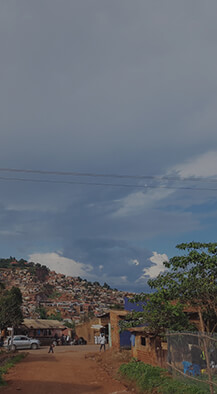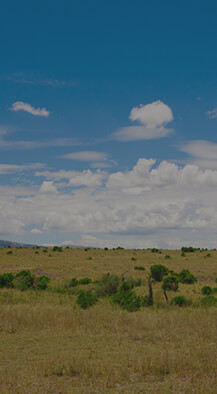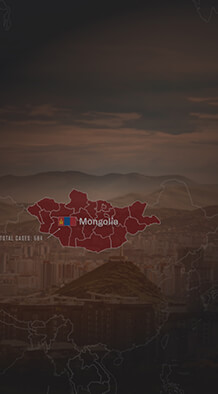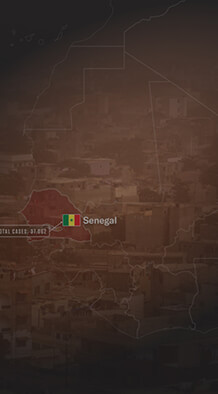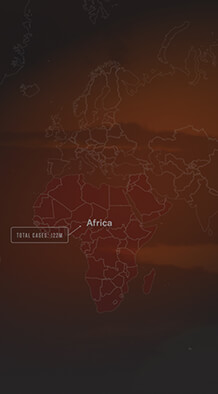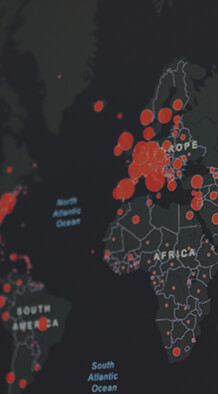COVID-19

Case Study:
COVID-19 in
Africa
Cases Overview*
- 12.7M Total Cases
- 0 Total Vaccines Administered
- 261.3K Deaths
Built on a commitment to collaboration over competition, swift action from Africa Centres for Disease Control and Prevention (Africa CDC) and political coordination led by the African Union helped galvanize a continent-wide response to COVID-19, dramatically expanding public health capacity and saving countless lives.
ABOUT SARS-COV-2
On December 31, 2019, a statement from the Wuhan Municipal Health Commission describing cases of pneumonia caused by an unknown virus was reported to the World Health Organization office in China.1 By April 2021, COVID-19, the disease caused by SARS-CoV-2, had killed more than 3 million people and infected at least 140 million worldwide.2
SARS-CoV-2 is a novel coronavirus. Coronaviruses were identified as a cause of the common cold in humans in the 1960s but were not considered a threat to public health. While colds can sometimes cause severe illness in infants and the elderly, they did not generally pose a great danger to the general population. That changed with the emergence of severe acute respiratory syndrome (SARS) in 2002 and Middle East respiratory syndrome (MERS) in 2012, both caused by new human coronaviruses that are more lethal and can cause severe illness in normally healthy people.3
By March 11, 2020, WHO had declared COVID-19 a global pandemic, prompting extreme lockdown measures and travel restrictions as the deadly disease spread all over the world. As humans had not yet encountered COVID-19, there was no natural immunity or established care protocols, and governments relied on public health and social measures such as quarantines, mask use and physical distancing to slow the spread while the scientific community rushed to develop treatments and vaccines.
Scientists were able to develop vaccines to protect against COVID-19 in less than a year. Typically, vaccine development takes five to 10 years.4 Doctors have also learned to better manage patient care, which in some areas has improved life expectancy. Still, there is no cure for COVID-19, and it may take years for vaccines to reach the global population. While countries work to address major hurdles to equitable distribution of vaccines, continued public health measures are still needed to save lives.
Disclaimer: These stories showcase various countries that executed preparedness plans to mount a strong initial response to COVID-19. As the pandemic stretches on and tests the capacities of all countries’ response efforts, increased cases, deaths and response missteps may still occur.

WHAT HAPPENED
Leaders of African Union member states watched warily as COVID-19 cases spread across the world in early 2020. Many African countries had fragile health systems, already burdened with major infectious disease epidemics of HIV, tuberculosis and malaria, along with occasional outbreaks of diseases such as Ebola and yellow fever. Managing COVID-19 would put further pressure on health care systems and force countries to compete for resources. On February 14, Egyptian authorities reported the first case of COVID-19 in Africa. An effective response was urgently needed to avoid tragedy on the continent.
THE RESPONSE
Although African countries individually prepared to tackle COVID-19, the leadership at Africa CDC recognized that a continent-wide response would be necessary to support state-level efforts and mobilize resources most effectively. Africa CDC—the public health arm of the African Union—had been launched just three years earlier to help increase African countries’ abilities to detect, prevent and respond to disease threats quickly and effectively. Although Africa CDC had already supported responses to several outbreaks, COVID-19 presented the first pandemic that would impact the entire continent.
By the time that first case arrived on the continent in February, Africa CDC had already taken a critical step: they had activated their emergency management system on January 27, enabling evaluation and planning to begin in earnest as cases spread across the world.5 Although many countries had systems in place to address disease outbreaks, COVID-19 presented particular difficulties. Only two countries were capable of testing for the virus—South Africa and Senegal—and many would face shortages of critical supplies, including personal protective equipment, ventilators, medical staff and contact tracers.
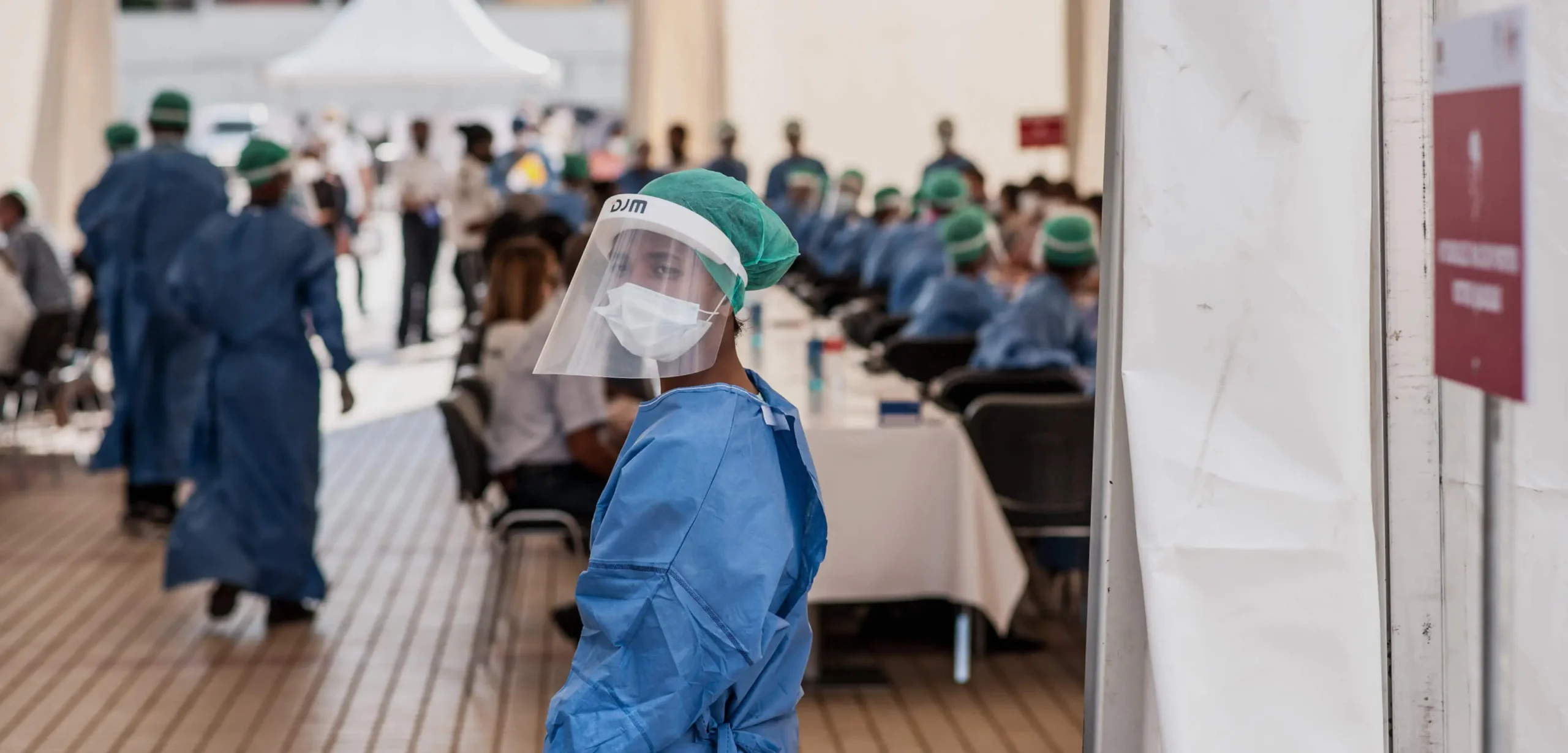
Key Preparedness Factors
-
Risk Assessment & Planning
-
Emergency Response Operations
-
National Laboratory System
-
Disease Surveillance
-
National Legislation Policy & Financing
-
Human Resources
-
Risk Communications
As Africa CDC staff identified gaps and prepared to support countries, they also worked with the highest levels of political leadership on the continent to ensure a coordinated response. By March, a continent-wide strategy devised by Africa CDC for managing the COVID-19 pandemic had been agreed to by all African heads of state.6 This allowed for a coordinated response across the continent, led by Africa CDC, with the benefits of country cooperation, instead of the competition that many countries elsewhere struggled with.
The strategy was clear: quick diagnosis and isolation of positive cases, quarantine of contacts, social distancing, effective public communications, reinforced infection prevention and control in hospitals and access to tools to treat severe cases. Drawing on experts from across the continent, along with WHO officials and external partners, Africa CDC established working groups to tackle each area.
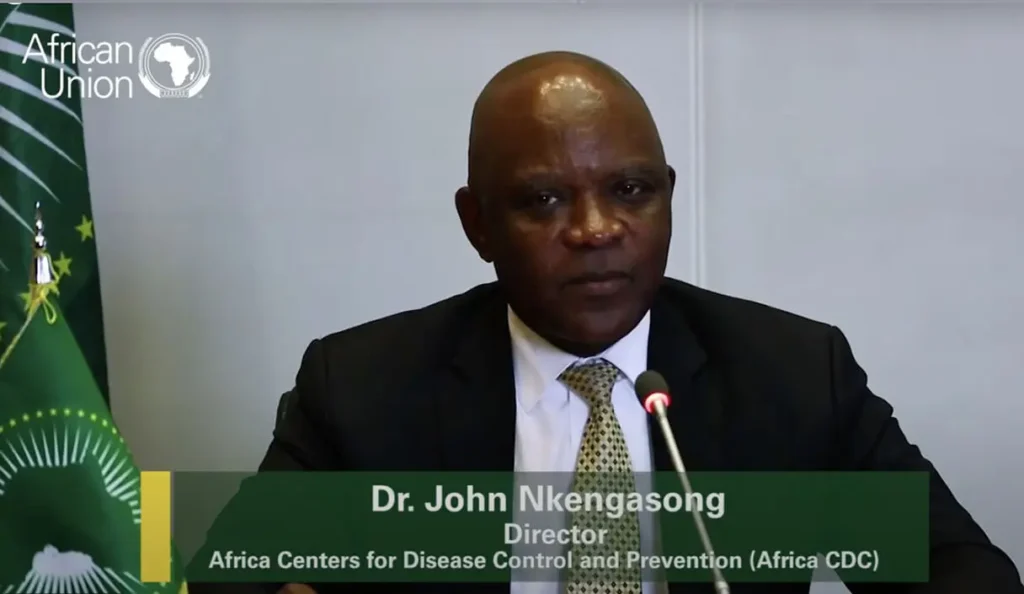
The greatest success is the political backup of the leaders of this continent who have understood that they need this kind of institution [Africa CDC] to overcome the health challenges they are facing on the continent.
Dr. Benjamin Djoudalbaye, Head, Division of Policy, Health Diplomacy and Communication at Africa CDC
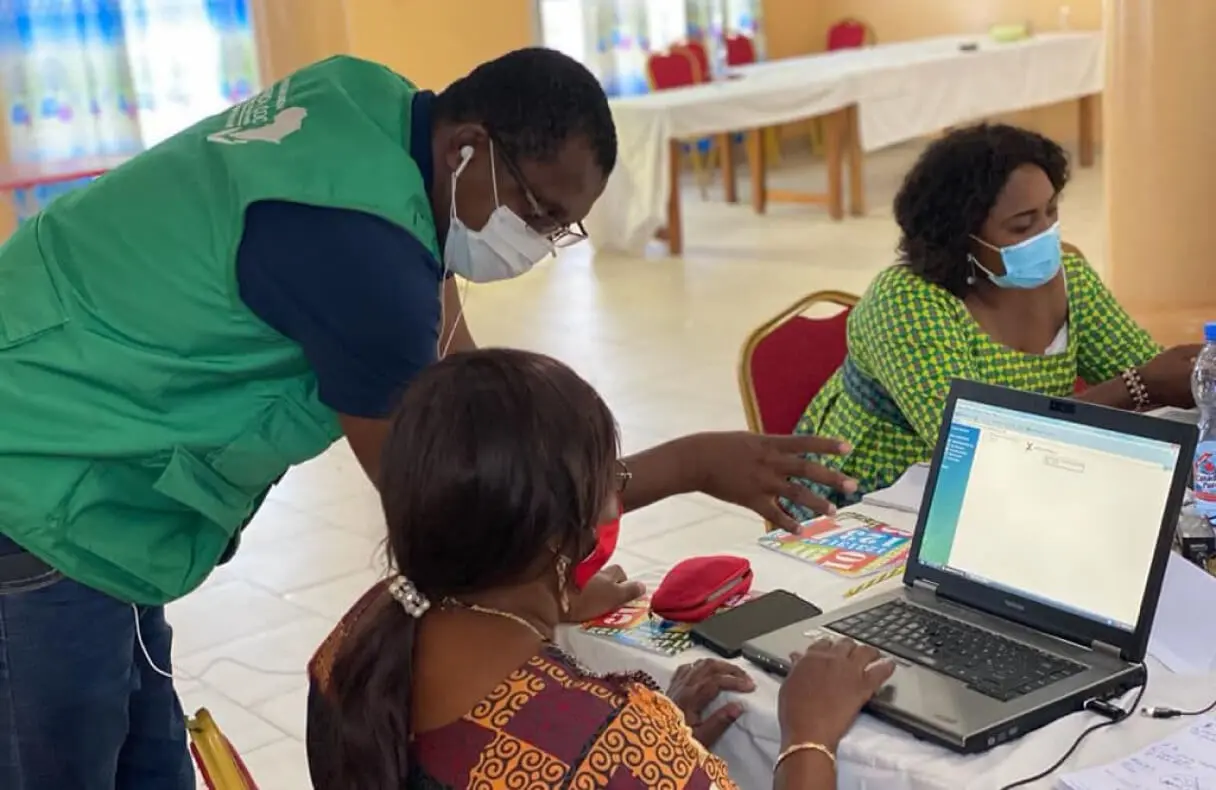
While the pandemic is not over yet, the African continent has seen many successes. Between February and April 2020, tens of thousands of clinicians and community health care workers were trained in the management of COVID-19. Testing capacity was expanded from two countries to 43, with nearly 20,000 lab staff trained and equipment previously used for HIV and tuberculosis testing repurposed for COVID-19.7 Africa CDC worked with countries to unite disparate disease surveillance systems, creating a continent-wide view of COVID-19 infections.8 Further, a pooled procurement system was established to reduce the cost of medical equipment. As vaccines have been approved, Africa CDC has worked to speed procurement. Through the committees established under the continent-wide cooperation strategy, experts regularly exchange data and share best practices.
Much of the success to date began with preparation. Lessons learned from past epidemics, such as Ebola, made possible a swift and coordinated response to COVID-19. When the virus arrived on the continent, Africa CDC had already established regional coordinating centers, increased lab capacity and unified surveillance networks. In 2015, African heads of state and government established the Africa Volunteer Health Corps, with responders that could be deployed in less than 72 hours during disease outbreaks and other health emergencies. As of now, 196 have now been sent across Africa to support responses. In addition, Africa CDC established the Pathogen Genomics Intelligence Institute, capable of sequencing viral genomes to track the evolution of COVID-19 variants. Initially, the target was to have these centers in three countries; currently there are centers in 16 countries, with ambitions to expand further still.
The work Africa CDC undertook from its inception, from investments in lab systems to clinical trainings, along with a fast response based on the principle of cooperation, has proven to be effective. The focus on collaboration over competition allowed countries to focus their energy on response activities. As of April 2021, the entirety of Africa had seen roughly 120,000 deaths, only a fifth of the death toll of the United States, despite having more than three times the population. While emerging variants in South Africa and elsewhere remain a threat, and Africa CDC warns against declaring victory too early, it is clear that the coordinated response spurred by Africa CDC has saved lives while better preparing the continent to address future outbreaks.
This case study was developed in partnership with the Africa Centres for Disease Control and Prevention.

We are seeing more coordination. The response is coordinated. Countries are talking to each other. Every Tuesday, all the continent – experts, members states, partners, including WHO, European CDC, US CDC – all these partners are joining the [Africa CDC] task force. This is a very good practice that will stay. And it is a very big success. In the previous outbreaks we have never seen Africa CDC or the AU leading such a forum bringing all of these stakeholders…to coordinate with us. To collaborate with us. To communicate with us. We are establishing communities of practice together.
Dr. Benjamin Djoudalbaye, Head, Division of Policy, Health Diplomacy and Communication at Africa CDC
*Compiled from the COVID-19 Dashboard by the Center for Systems Science and Engineering at Johns Hopkins University
References
- World Health Organization. (2020a). Timeline: WHO’s COVID-19 response. https://www.who.int/emergencies/diseases/novel-coronavirus-2019/interactive-timeline
- The New York Times. (2021, March 15). Coronavirus World Map: Tracking the Global Outbreak. The New York Times. https://www.nytimes.com/interactive/2020/world/coronavirus-maps.html
- Cui, J., Li, F., & Shi, Z. (2018, December 10). Origin and evolution of pathogenic coronaviruses. Nature Reviews Microbiology. https://www.nature.com/articles/s41579-018-0118-9
- Johns Hopkins Coronavirus Resource Center. (n.d.-b). Vaccine Research & Development. https://coronavirus.jhu.edu/vaccines/timeline
- Africa Centres for Disease Control and Prevention. (2020, September 11). Africa Joint Continental Strategy for COVID-19 Outbreak. https://africacdc.org/download/africa-joint-continental-strategy-for-covid-19-outbreak/
- Africa Centres for Disease Control and Prevention. (2020, September 11). Africa Joint Continental Strategy for COVID-19 Outbreak. https://africacdc.org/download/africa-joint-continental-strategy-for-covid-19-outbreak/
- Ondoa, P., Kebede, Y., Loembe, M. M., Bhiman, J. N., Tessema, S. K., Sow, A., Sall, A. A., & Nkengasong, J. (2020). COVID-19 testing in Africa: lessons learnt. The Lancet, e103–e104. https://www.thelancet.com/pdfs/journals/lanmic/PIIS2666-5247(20)30068-9.pdf
- Centers for Disease Control and Prevention. (2020). Africa CDC Launches Continent-wide Response | Division of Global Health Protection | Global Health | CDC. https://www.cdc.gov/globalhealth/healthprotection/fieldupdates/fall-2020/africa-cdc-covid.html


